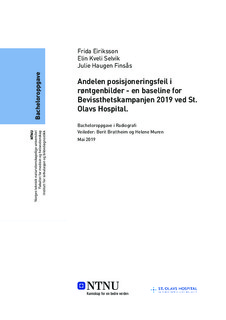| dc.contributor.advisor | Brattheim, Berit | |
| dc.contributor.advisor | Muren, Helene | |
| dc.contributor.author | Eiriksson, Frida | |
| dc.contributor.author | Selvik, Elin Kveli | |
| dc.contributor.author | Finsås, Julie Haugen | |
| dc.date.accessioned | 2019-09-06T14:02:49Z | |
| dc.date.available | 2019-09-06T14:02:49Z | |
| dc.date.issued | 2019 | |
| dc.identifier.uri | http://hdl.handle.net/11250/2613208 | |
| dc.description.abstract | Hensikten med studien: Hensikten med dette bachelorprosjektet var å se på hvor stor andel
røntgenbilder tatt på St. Olavs Hospital (Øya) som inneholdt posisjoneringsfeil, samt hvor
mange anatomiske bildekriterier som ble oppfylt på hvert bilde. Målet var å danne en
baseline for Bevissthetskampanjen 2019 “Hvor mange likes får ditt røntgenbilde?”
Materiale og metode: Dette bachelorprosjektet har et kvantitativt design. For å samle inn
hoveddatagrunnlaget ble det gjennomført en bildeevalueringsprosess hvor 275
røntgenbilder tilfeldig utvalgt fra St. Olavs Hospital (Øya) ble vurdert med anatomiske
bildekriterier som grunnlag. Røntgenbildene som ble inkludert i bachelorprosjektets
datamateriale var fordelt på fire ulike røntgenprosedyrer: Fot (projeksjonene: front, skrå),
ankel (projeksjonene: front, skrå, side), lumbosacralcolumna (projeksjonene: front lumbal,
front sacrum, side lumbal, side sacrum), og skulder (projeksjonene: front innadrotert,
transscapulær).
Resultat: Av 275 bilder var det 155 bilder som inneholdt posisjoneringsfeil, noe som tilsvarer
56%. Fordelingen av røntgenbilder som inneholdt posisjoneringsfeil så slik ut: fot: 92%,
ankel: 67%, lumbosacral: 28% og skulder: 60%. Fra resultatene kunne vi antyde et mønster
når det gjaldt sammenhengen mellom antall bildekriterier og antall bilder som inneholdt
posisjoneringsfeil. Færre bildekriterier resulterte i færre bilder med posisjoneringsfeil.
Hovedtyngden posisjoneringsfeil omhandlet leddspalter.
Oppsummering: Resultatene viste at det var behov blant radiografene for å bli mer bevisst
på bildekriterier og anatomisk posisjonering. På en annen side kunne kvaliteten på bildene
være god nok til å besvare pasientens kliniske problemstilling, noe vi ikke kunne vurdere på
grunnlag av begrenset informasjon i utvalget. For å forbedre kvaliteten på arbeidet kan
automatiserte tilbakemeldingsverktøy og prosedyreendringer være mulige løsninger.
Nøkkelord: Kvalitet, kvalitetssikring, bildekriterier, posisjoneringsfeil, radiograf | |
| dc.description.abstract | Purpose of the study: The purpose of this study was to investigate the percentage
positioning errors of x-ray images taken at St. Olavs Hospital (Øya), and how many
anatomical image criteria that were met in each image. The results will be used as a baseline
for the awareness campaign 2019 “How many likes does your x-ray photo get?”.
Material and method: This study has a quantitative design. In order to collect the main data
base, an image evaluation process was carried out in which 275 x-ray images randomly
selected from St. Olav's Hospital (Øya) were evaluated with image criteria as a foundation.
The x-rays included in the study were divided into four different x-ray-procedures: foot
(projections: front, oblique), ankle (projections: front, oblique, side), lumbosacralspine
(projections: front lumbar spine, front sacrum, side lumbar spine, side sacrum), and shoulder
(projections: front inward rotated, trans-scapular)
Results: Of 275 images, there were 155 images (56%) that contained positioning errors.
The distribution of x-ray procedures containing positioning errors looked like this: foot: 92%,
ankle: 67%, lumbosacral spine: 28% and shoulder: 60%. From the results, there could be
seen a weak pattern between the number of image criteria for the projection and the
number of images containing positioning errors. Fewer image criteria resulted in fewer
images with positioning errors. The bulk of the positioning errors concerned joint slits.
Summary: The results showed that there was a need for radiographers to become more
aware of image criteria and anatomical positioning. On the other hand, the quality of the
images may be good enough to answer the patient's clinical problem, which we could not
consider based on limited information in the sample. In order to improve the image quality,
automated feedback tools and procedure changes can be possible solutions.
Keywords: Quality, quality assurance, image criteria, positioning errors, radiographer | |
| dc.language | nob | |
| dc.publisher | NTNU | |
| dc.title | Andelen posisjoneringsfeil i røntgenbilder - en baseline for Bevissthetskampanjen 2019 ved St. Olavs Hospital. | |
| dc.type | Bachelor thesis | |
